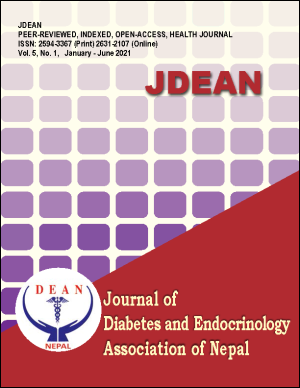Hypogonadotropic-hypogonadism (Kallman Syndrome) in Young Adult
DOI:
https://doi.org/10.3126/jdean.v5i1.38917Keywords:
Hypogonadotropic-hypogonadism, Kallmann Syndrome, olfactogenital dysplasiaAbstract
Background: Kallmann syndrome (KS) is a rare disorder first described in 1856 and later studied by Kallmann in 1944. It is now designated as olfactogenital dysplasia with an association between agenesis of the olfactory bulbs and hypogonadism. The prevalence of KS is still unknown. The reported incidence is 1 in 8000 to 1 in 10 000 in men and rare in women. More than 24 genes are underlying KS that have been identified. Mutations in these genes are thought to interfere with the expression of cell markers that guide migrating neurons, leading to failed migration of GnRH neurons and olfactory neurons to the forebrain during fetal development. The main clinical characteristics of KS include hypogonadotropic hypogonadism and anosmia or hyposmia. Less common phenotypes include cardiovascular anomalies, unilateral renal agenesis, cleft palate and cleft lip, cryptorchidism and osteoporosis. Magnetic resonance imaging (MRI) can show abnormalities of the olfactory system and other forebrain structures. Other exceptions may be discovered using MRI because of its high resolution and multiplanar capabilities, such as pituitary abnormalities.
Downloads
Downloads
Published
How to Cite
Issue
Section
License
Copyright (c) 2021 M. Totaganti, D. Sharma, Ravi Kant

This work is licensed under a Creative Commons Attribution-NonCommercial 4.0 International License.
This license enables reusers to distribute, remix, adapt, and build upon the material in any medium or format for non-commercial purposes only, and only so long as attribution is given to the creator.




